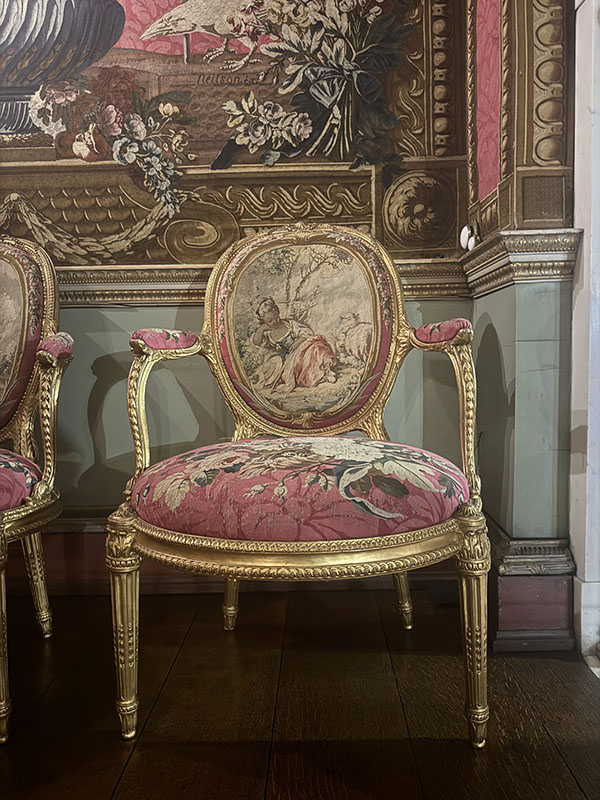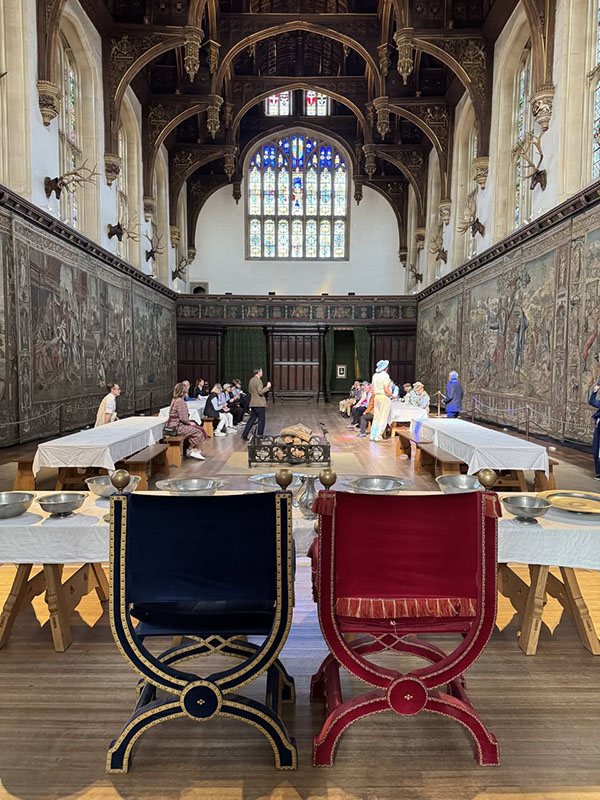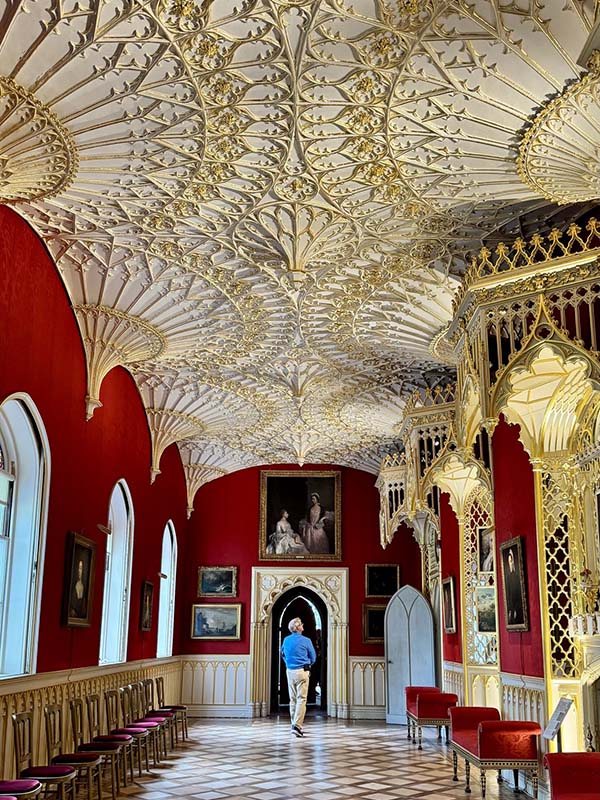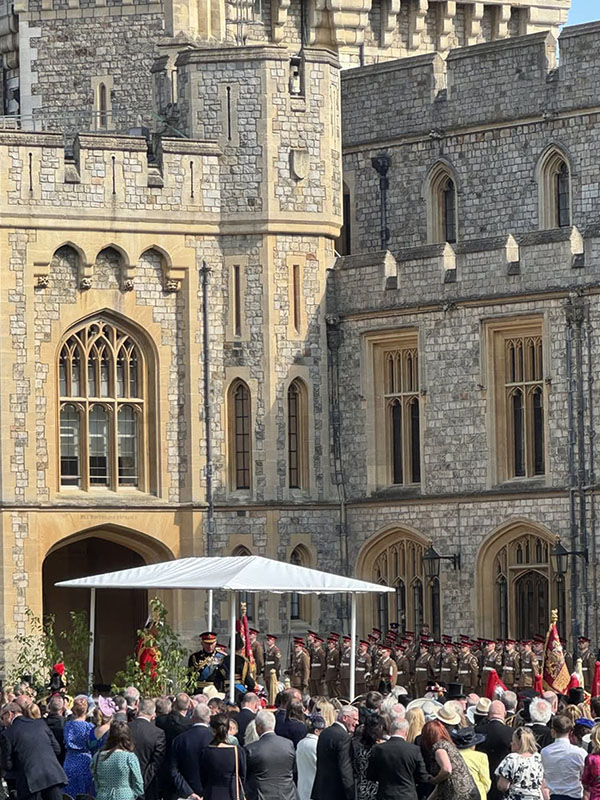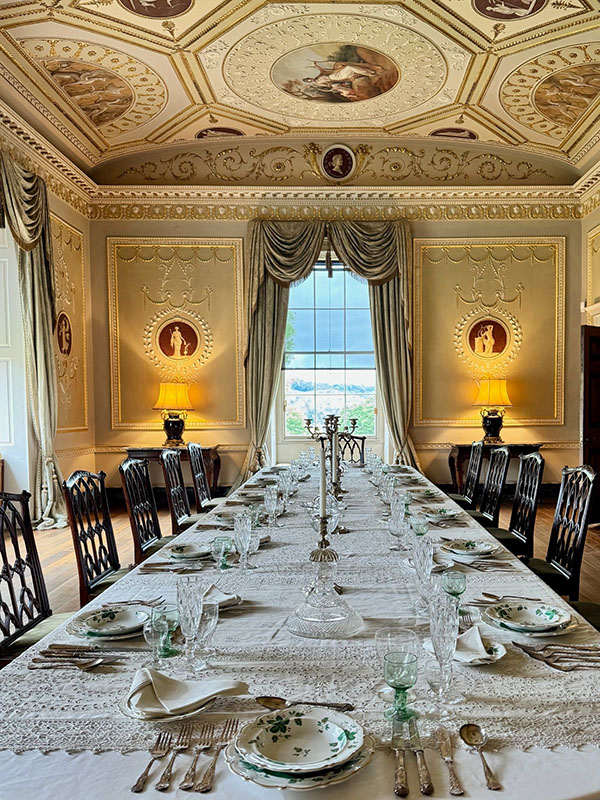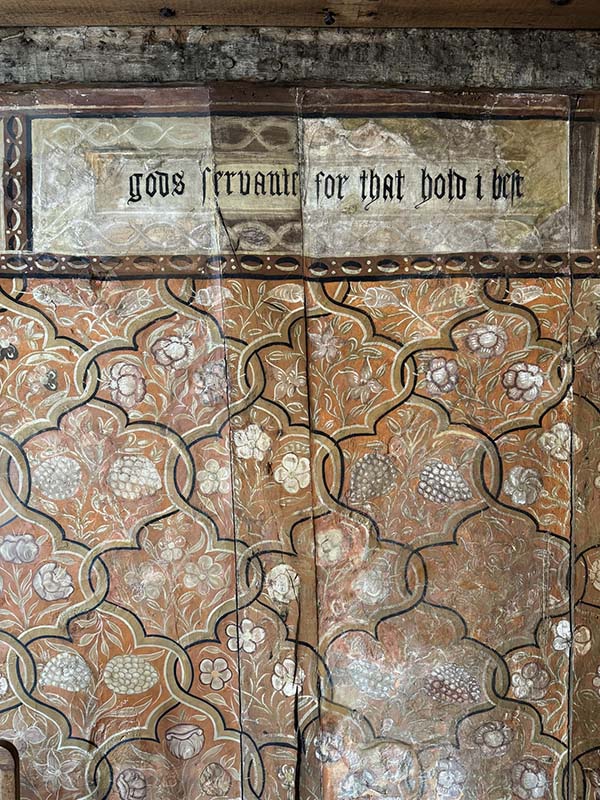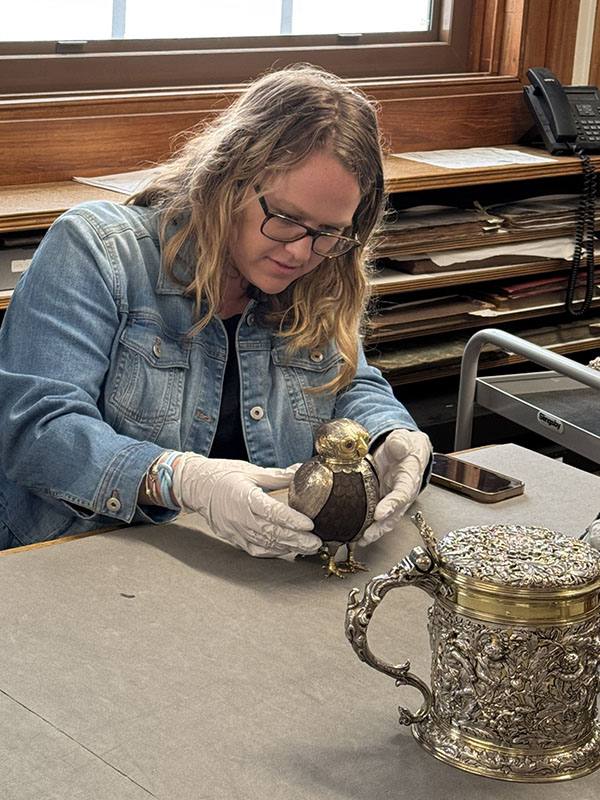Along the River: Thames Valley Exploration a Royal Treat
England’s spectacular Thames Valley provided a beautiful backdrop for our travels from London to Oxford, stopping at stunning castles and country houses along the way. Members truly enjoyed exploring this region’s decorative arts legacy, both on land and on the river. This brief synopsis of our spring Study Trips Abroad in May and June 2025 is offered with a reminder that a third tour is scheduled for September, and we are happy to add your name to our waitlist!
London and Environs
Megan Wheeler, the National Trust’s Assistant National Curator of Furniture, provided an exemplary introductory lecture at the c. 1665 Mitre Hotel, setting the stage for all we would encounter over the course of the next 8 days. Afterward, Megan accompanied us to Osterley Park and shared the magnificent state rooms designed by Robert Adam in the late 1700s and impressive objects and art they contain. Curators Polly Putnam and Lee Prosser introduced Kew Palace and Gardens in London’s Richmond Borough, originally built in 1631. George III and Charlotte made various internal alterations in the early 1800s, but the façade, with its distinctive and charming Dutch gables and brickwork, remains very much as first built. Guests enjoyed some free time to explore the extraordinary (and extensive!) gardens as well. Ham House near Richmond is perhaps the best surviving example of the court taste popularized during the reign of Charles II. Dr. Hannah Mawdsley from the National Trust and Jenny Saunt from the Victoria & Albert Museum shared insights about its lavish decor and furnishings.
The monumental Hampton Court Palace sits on the Thames and dates to 1515, and we were fortunate to tour it privately with Sebastian Edwards, Deputy Chief Curator at Historic Royal Palaces. In 1689, William III and Mary added Baroque splendor with the help of Sir Christopher Wren and Grinling Gibbons, and George II and Caroline retained William Kent to embellish the interiors in 1734. Curator Amy Lin showed us the Faringdon Collection in an early-19th-century townhouse on Brompton Square in Kensington, which features important examples of Regency and Biedermeier furniture and a picture collection ranging from Old Masters to Modern.
Marble Hill is a 1724–29 Palladian villa in parkland on the Thames developed by the inimitable Henrietta Howard and features a beautiful Great Room facing the river. We were greeted by Curator Dr. Silvia Davoli at Strawberry Hill House, the c. 1747 Gothic Revival masterpiece by Horace Walpole, the third son of Sir Robert Walpole, Britain’s first Prime Minister, and brother of Robert Walpole of Houghton Hall in Norfolk. We concluded our time exploring London’s western reaches with a restorative river cruise on the Thames, where we caught alternate views of Marble Hill, Ham House, and Hampton Court over evening refreshments.
Heading West
Before turning upriver, we devoted a morning to Chiswick House, a diminutive but important 1727–29 structure by Richard Boyle, 3rd Earl of Burlington, with his protégé William Kent designing the interiors and furniture. Harry Nordin and David Jacques were excellent resources during our exploration of the house and garden, respectively. A visit to this region would not be complete without venturing to Windsor Castle, the largest castle in Britain and the largest occupied castle in the world. After the castle closed to the visiting public, we were treated to a superb evening tour of the State Apartments with the truly incredible fine and decorative art collections they contain. Participants in the May tour even got to see King Charles III performing a military ceremony! After an eventful day, members settled at the lovely Langley Hotel, an impressive 18th-century Palladian mansion nestled within Buckinghamshire’s Langley Park, where Hollywood A-listers stay while working on film and television series at the nearby Pinewood Studios.
Megan Aldrich shared insights about Basildon Park, a Palladian villa near Reading in Berkshire, designed by John Carr of York in 1776 with superlative furniture holdings. Best known as the host of a renowned regatta, the nearby Henley-on-Thames dates back to 1179. Members enjoyed scenic views and historic architecture during a guided walking tour. Dorney Court, a Tudor manorial complex near Windsor in Buckinghamshire, has remained the residence of the Palmer family since the 17th century and offered an opportunity to learn about the logistics of sustaining a centuries-old country house in the 21st century. .
Heading to Oxfordshire, Buscot Park was built 1780–83. Acquired by the Faringdon family in the late 19th century, the estate includes a splendid garden and an extraordinary collection. The Hall is furnished with spectacular c. 1800 black-and-gold-painted chairs and sofas designed by Thomas Hope, and the Saloon contains Edward Burne-Jones’s series of paintings of the Legend of the Briar Rose (Sleeping Beauty), housed in frames designed by the artist for the room. Kelmscott Manor, a gabled grey stone house first built c. 1570, is inseparably connected with the author, craftsman, and pioneer socialist William Morris, who owned the residence from 1871 until his death in 1896. Martin Levy shared their insights into the house and Morris’s work, family, and circle of friends. Our final visit before departing for Oxford was Kingston Bagpuize near Abingdon, a little-altered c. 1700 house of red brick dressed with Burford stone. The charming mother-daughter ownership team of Virginia and Elizabeth Grant shared their experience at the helm of this country estate.
Exploring Oxford
The Randolph Hotel, built in 1863–66 to the restrained Gothic Revival designs of William Wilkinson, served as our centrally located Oxford headquarters. Participants enjoyed a walking tour of this historic university city with Stephen Dawson, during which we studied the Sheldonian Theatre, built 1664–69 after plans by Christopher Wren, and the Radcliffe Camera, constructed 1737–48 to designs by James Gibbs. The Bodleian Library and Divinity School boast striking spaces, with the oldest extant part of the Library dating back to the late 15th century. A little-known decorative arts wonder in Oxford is known as the Painted Room, and we were thrilled to have the chance to see the Elizabethan wall paintings from the late 16th century. Although the room’s connection to William Shakespeare is tenuous, the surviving interiors were definitely worth our attention.
William Whyte of St. John’s College led our afternoon tours. Switching from painted flora to the real material, the Oxford Botanic Garden, founded 1621, is Britain’s oldest botanic garden and was especially lovely this time of year. Nearby Magdalen College features mason William Orchard’s iconic bell tower, built between 1492 and 1508. William Whyte brought us through the full sequence of academic spaces, including the Cloister, Chapel, and Hall. The breathtaking Christ Church was originally founded in 1524, with Christopher Wren designing a new bell tower in 1682.
The Ashmolean Museum was Britain’s first public museum and boasts an impressive collection. We were thrilled to participate in a hands-on object study with curators Matthew Winterbottom and An Van Camp, focusing on silver and design drawings, respectively. Retired Victoria & Albert curator Sarah Medlam brought the group to the gorgeous Trinity College Chapel, which showcases extensive carved woodwork by Grinling Gibbons and grand paintings by Pierre Berchet. The Oxford University Museum of Natural History, opened in 1860 to designs by architects Thomas Newham Dean and Benjamin Woodward, and the attached Pitt Rivers Museum, provided fascinating glimpses into historic collections.
If you are interested in attending the September Thames Valley Study Trip Abroad, please contact us at thetrust@decorativeartstrust.org or 610.627.4970 to request a spot on the waitlist. Information about terms and conditions can be found on our website.
For more information about Osterley Park and Ham House, view Megan Wheeler’s magazine article, and for more images from the May and June Study Trips Abroad, visit our Facebook and Instagram pages.
About The Decorative Arts Trust Bulletin
Formerly known as the "blog,” the Bulletin features new research and scholarship, travelogues, book reviews, and museum and gallery exhibitions. The Bulletin complements The Magazine of the Decorative Arts Trust, our biannual members publication.
Click Images to Enlarge
Did you know that clicking on the images in Bulletin posts will allow you to get a closer look? Simply click on an image, and a larger version will open in a pop-up window.








